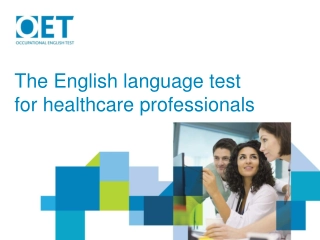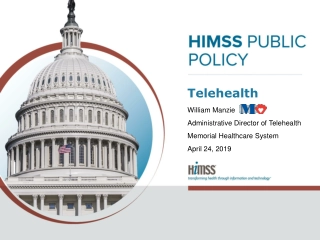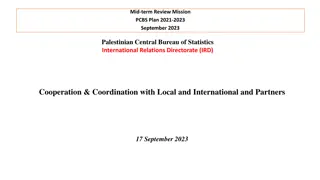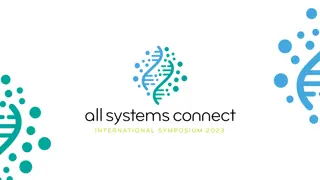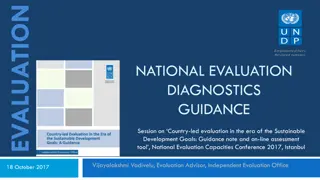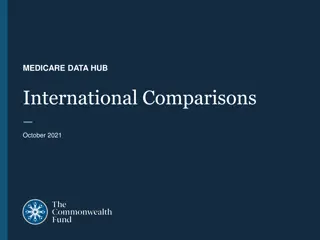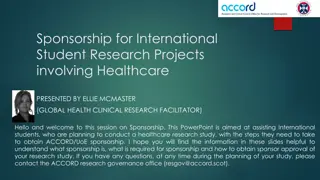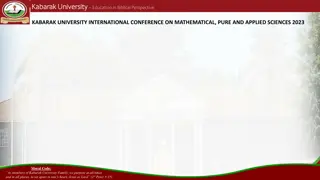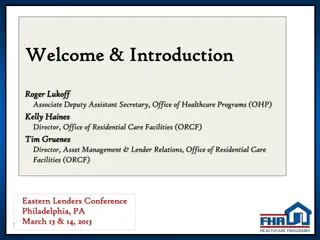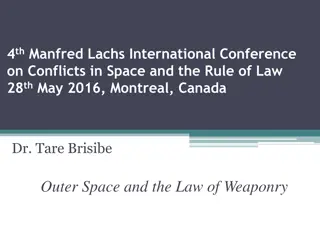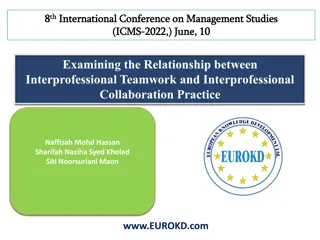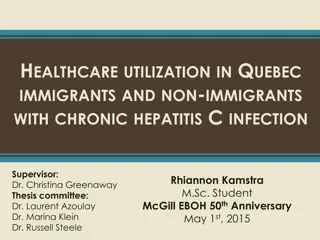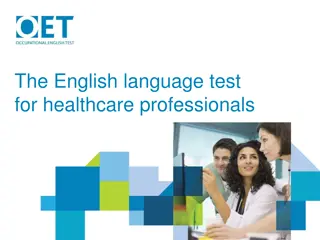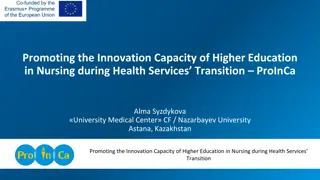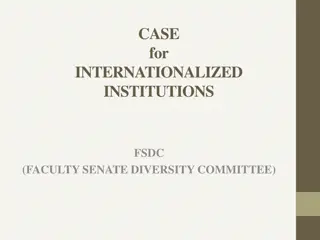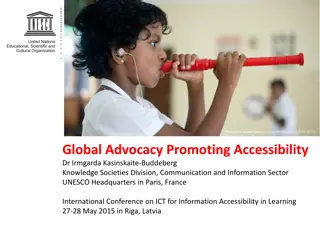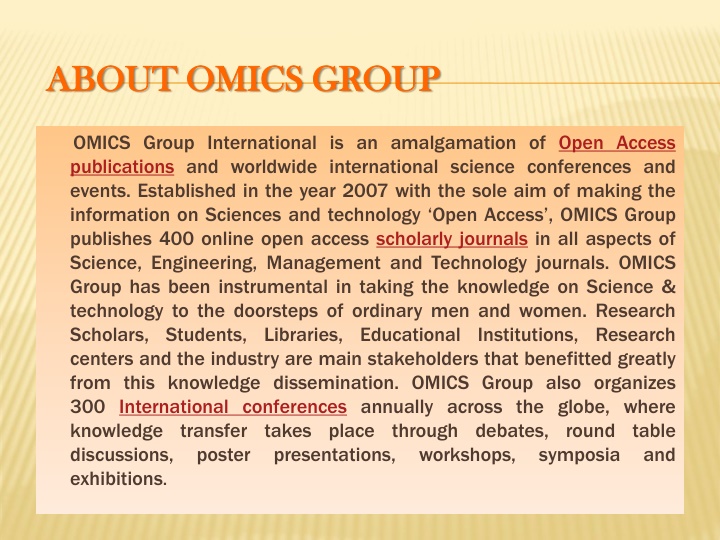
Kabarak University International Conference on Strengthening Healthcare Delivery and Innovations
This conference aims to bridge the gap between industry and academia to enhance healthcare delivery and foster innovations. Join us on 3/14/2025 for insightful discussions and networking opportunities.
Uploaded on | 2 Views
Download Presentation

Please find below an Image/Link to download the presentation.
The content on the website is provided AS IS for your information and personal use only. It may not be sold, licensed, or shared on other websites without obtaining consent from the author. If you encounter any issues during the download, it is possible that the publisher has removed the file from their server.
You are allowed to download the files provided on this website for personal or commercial use, subject to the condition that they are used lawfully. All files are the property of their respective owners.
The content on the website is provided AS IS for your information and personal use only. It may not be sold, licensed, or shared on other websites without obtaining consent from the author.
E N D
Presentation Transcript
ABOUT OMICS GROUP ABOUT OMICS GROUP OMICS Group International is an amalgamation of Open Access publications and worldwide international science conferences and events. Established in the year 2007 with the sole aim of making the information on Sciences and technology Open Access , OMICS Group publishes 400 online open access scholarly journals in all aspects of Science, Engineering, Management and Technology journals. OMICS Group has been instrumental in taking the knowledge on Science & technology to the doorsteps of ordinary men and women. Research Scholars, Students, Libraries, Educational Institutions, Research centers and the industry are main stakeholders that benefitted greatly from this knowledge dissemination. OMICS Group also organizes 300 International conferences annually across the globe, where knowledge transfer takes place through debates, round table discussions, poster presentations, exhibitions. workshops, symposia and
ABOUT OMICS GROUP CONFERENCES ABOUT OMICS GROUP CONFERENCES OMICS Group International is a pioneer and leading science event organizer, which publishes around 400 open access journals and conducts over 300 Medical, Clinical, Engineering, Life Sciences, Phrama scientific conferences all over the globe annually with the support of more than 1000 scientific associations and 30,000 editorial board members and 3.5 million followers to its credit. OMICS Group has organized 500 conferences, workshops and national symposiums across the major cities including San Francisco, Las Vegas, San Antonio, Omaha, Orlando, Raleigh, Santa Clara, Chicago, Philadelphia, Baltimore, United Kingdom, Valencia, Dubai, Beijing, Hyderabad, Bengaluru and Mumbai.
FORENSIC RESEARCH AND TECHNOLOGY CONFERENCE SAN ANTONIO (USA): 6 OCTOBER 2014 A A New New Multidisciplinary Multidisciplinary Approach Lessons Lessons From From Disasters Disasters (Forensic of of Disasters Disasters (FORIN)) (FORIN)): : Researching Disasters Disasters Approach to to Learn (Forensic Investigations Investigations Researching Causes Learn Causes in in Djillali BENOUAR Djillali BENOUAR USTHB, USTHB, Algeria Algeria , , Periperi Periperi U Partner U Partner IRDR Science Committee Member IRDR Science Committee Member dbenouar@gmail.com dbenouar@gmail.com
GENERALLY, RESPONSIBILITY FOR DISASTER LOSSES IS WIDELY SPREAD OVER INSTITUTIONS AND OVER SPACE AND TIME
THE THE CAUSES CAUSES OF ENGINEERING ENGINEERING SOCIO VARIOUS VARIOUS GEOPHYSICAL GEOPHYSICAL AND FACTORS FACTORS. . OF DISASTERS DISASTERS ARE SOCIO- -ECONOMIC, ECONOMIC, SOCIO AND HYDROMETEOROLOGICAL HYDROMETEOROLOGICAL ARE DRIVEN DRIVEN BY SOCIO- -CULTUREL, BY COMPLEX COMPLEX CULTUREL, AND AND SUCH SUCH INTERACTING INTERACTING FACTORS, RANGE RANGE OF OF TEMPORAL TEMPORAL AND SEVERAL SEVERAL WAYS WAYS TO TO CONFIGURE FACTORS, OCCURING AND SPATIAL SPATIAL SCALES, CONFIGURE DISASTERS DISASTERS RISKS OCCURING ACROSS SCALES, COMBINED COMBINED IN RISKS. . ACROSS A A IN USING USING SOME DYNAMICS DYNAMICS OF WILL WILL BE BE EXPLORED METHODOLOGY, METHODOLOGY, NAMELY DISASTERS DISASTERS PROGRAMME PROGRAMME. . SOME SELECTED SELECTED DISASTERS OF SUCH SUCH RISKS RISKS AND EXPLORED USING NAMELY FORENSIC (FORIN (FORIN STUDIES) STUDIES) DISASTERS IN AND THEIR THEIR CONFIGURATIONS CONFIGURATIONS USING A A NEW NEW APPROACH FORENSIC INVESTIGATIONS INVESTIGATIONS OF DEVELOPED DEVELOPED IN ALGERIA, ALGERIA, THE THE APPROACH AND AND OF IRDR IRDR BY BY
INTRODUCTION Our Our knowledge knowledge of of the and and how how to to e effectively risks risks has has grown years, years, but but to to judge seriously seriously considerable considerable amounts are are available available are deployed, deployed, nor implemented implemented.. .. the causes causes of of disasters ectively manage manage disaster grown considerably considerably in in recent judge by by results results it it remains inadequate inadequate. . Moreover, Moreover, amounts of of information information that are not not being being adequately nor e effectively ectively used disasters disaster recent remains the the that adequately used and and
INTRODUCTION (CONT) A A more approach approach to to understanding causes causes of of a a disaster disaster would long long way way in in supporting supporting future based based decision decision- -making, increasing increasing accountability accountability for policy policy- -making making in in disaster more demanding demanding and understanding the and penetrating penetrating the actual would potentially potentially go future evidence making, as as well for responsible disaster risk risk reduction reduction actual go a a evidence- - well as responsible as
THE CURRENT RESEARCH DEFICIT The The question question is is why, is is known known about events, events, including including extremes, technological technological stronger, stronger, are are large and and medium medium- -scale becoming becoming more more frequent continuing continuing to to increase increase at at a a rapid why, when when so about the the science extremes, and capacity capacity large- -scale scale and scale disasters disasters apparently frequent and so much much more science of of natural and when is is so so and even even small apparently and the the losses rapid rate rate. . more natural when much much small- - losses
There There has substantial substantial expansion potential potential magnitude natural natural events events and more more likely likely to to occur has been expansion of of knowledge magnitude and and the the places occur. . been over over the the last knowledge about and frequency frequency of of many places in in which which they last 60 60 years years a a about the the many they are are Often Often the increases increases in in human wealth, wealth, and hazardous hazardous locations the increase increase in in losses human population and their their expansion locations. . losses is is attributed population and expansion into attributed to to and material material into more more This is certainly part of the explanation. This is certainly part of the explanation.
It It is is also knowledge knowledge and are are not not uniformly that that many many developing have have a a lower lower capacity introduce introduce technology technology that available available due due to to institutional social social capacity capacity constraints perhaps perhaps more more importantly, importantly, cultural and and resource resource scarcity scarcity reasons also true and modern uniformly distributed developing countries capacity to to utilize the the science science that is is theoretically institutional or or constraints or, true that modern technology technology distributed and that scientific scientific and countries utilize or or and and theoretically or, cultural reasons. .
But But the to to occur occur in in developed that that there there must must be than than access access to to science choice choice of of location, location, and the fact fact that developed countries be more more to to the science and and resource that major major disasters disasters continue countries suggests the explanation explanation and technology technology, , and resource scarcity scarcity. . continue suggests and THIS THIS POINTS DEFICIENCY DEFICIENCY IN EXISTING EXISTING RESEARCH POINTS TO IN THE RESEARCH ON TO A A DEFICIT THE PREPONDERANCE PREPONDERANCE OF ON DISASTERS DISASTERS. . DEFICIT AND AND A A OF
After After a a major that that an an enquiry undertaken undertaken into When When such such investigations investigations are there there have have been been many), heavily heavily on on either either the processes processes or or the the technological aspects aspects of of the the damage damage. . major disaster disaster event enquiry is is made into the the causes event it it often made or or new causes and and consequences consequences. . are conducted conducted (and many), they they typically typically focus the geophysical geophysical or or atmospheric technological and often happens happens new research research (and focus atmospheric and structural structural
Emergency Emergency preparedness and and rehabilitation rehabilitation response examined examined. . preparedness and and the the disaster disaster relief are also also often relief often response are Sometimes Sometimes an e effectiveness ectiveness of of existing recommendations recommendations improvements improvements. . an enquiry enquiry may existing policy for for may extend extend to to the policy and and make future future the make policy policy These These e efforts into into the the more term term causes causes of of the orts rarely rarely seem more underlying underlying and the disaster seem to to probe and sometimes sometimes longer disaster. . probe very very deeply deeply longer- -
Nor Nor are arm s arm s length and and responsible responsible. . This extent extent that that those and and on on the the spot what what occurred, occurred, but are the length from the enquiries enquiries necessarily from those those most This is is understandable those consumed consumed in in disaster spot have have the the most but not not necessarily necessarily why necessarily carried most intimately intimately involved understandable to to the disaster response most knowledge knowledge of of just why or or how carried out out at at involved the response just how. . One One consequence consequence appears tend tend to to leave leave many even even not not asked asked. . Is Is it it also would would argue, argue, that when when many many are physically physically and and from disorder disorder that that there creating creating more more distress the the causes causes. . appears to to be many questions questions unanswered also the the case, that in in the the aftermath aftermath of of a a disaster are su suffering ering materially from post post- -traumatic traumatic stress there may may be be reluctance reluctance to to risk distress by by probing probing too be that that enquiries enquiries unanswered or or case, as as some some disaster and stress materially and risk into too deeply deeply into
The The need optimistic optimistic vision to to trump trump probing need to to restore vision of of the probing investigations investigations of of causes restore confidence confidence and the future future frequently and build frequently seems causes. . build an seems an IN IN CONSEQUENCE, CONSEQUENCE, THE BUILDING BUILDING BACK UNREALIZED UNREALIZED. . THE STATED STATED OBJECTIVE BACK BETTER BETTER MAY OBJECTIVE OF MAY REMAIN REMAIN OF
WHY FORENSIC INVESTIGATIONS? Such studies studies will will search search for fundamental fundamental explanations explanations for losses losses. . These These might might extend extend from knowledge knowledge in in some some instances instances to to the of of available available knowledge knowledge. . Commonly Commonly identified investigations investigations are are poor poor building building standards, design design of of infrastructure infrastructure and and human Such for additional, additional, wider for the the on on- -going from gaps the ine ineffective identified in in previous standards, planning human settlements settlements. . wider and going rise rise in in disaster gaps in in scientific ective application application and more more disaster scientific previous planning and and Less Less frequently frequently addressed and and why why decisions decisions were chosen chosen. . addressed are were made are questions questions concerning made and and management management options concerning how how options This This applies applies not many many everyday everyday incremental cultural cultural practices, practices, beliefs resilience resilience and and vulnerability vulnerability of of communities not only incremental decisions beliefs and and perceptions only to to major major policy decisions and perceptions that communities. . policy choices choices but and social but to to the social and that shape shape the the and the
FORENSIC FORENSIC APPROACH PICTURE PICTURE OF OF A A DISASTER APPROACH IS IS PERHAPS DISASTER PUZZLE PERHAPS SIMILAR PUZZLE. . SIMILAR TO TO SOLVING SOLVING A A THE THE OBJECTIVE OBJECTIVE IS IS TO CAUSES CAUSES OF OF COMPREHENSIVE, COMPREHENSIVE, TRANSPARENT, FORENSIC FORENSIC STYLE STYLE. . TO DIG DISASTERS DISASTERS TRANSPARENT, AND DIG MORE MORE DEEPLY IN IN AND INVESTIGATIVE INVESTIGATIVE OR DEEPLY INTO AN AN INTEGRATED, INTEGRATED, INTO THE THE OR TO TO ESTABLISH ESTABLISH A A SOUND RELIES RELIES UPON UPON THE APPLIES APPLIES ACCEPTED ACCEPTED SCIENTIFIC PRINCIPLES PRINCIPLES TO TO INTERPRET PROCESS PROCESS. . SOUND BASIS THE ACTUAL ACTUAL EVIDENCE SCIENTIFIC METHODOLOGIES METHODOLOGIES AND INTERPRET THE THE DISASTER DISASTER IN BASIS FOR EVIDENCE FOUND FOR ANALYSIS, ANALYSIS, FORIN FOUND AND FORIN AND AND ALL ITS IN ALL ITS OFTEN, OFTEN, THE APPLICATION APPLICATION SIMIULTANEOUSLY SIMIULTANEOUSLY. . THE ANALYSIS ANALYSIS REQUIRES OF OF SEVERAL SEVERAL REQUIRES THE SCIENTIFIC SCIENTIFIC THE SIMULTANEOUS SIMULTANEOUS DISCIPLINES DISCIPLINES
FOUR FOUR HYPOTHESES HYPOTHESES ARE ARE FORMULATED FORMULATED AS AS: : NEW AND MORE PROBING RESEARCH NEW AND MORE PROBING RESEARCH AND UNDERSTANDING OF THE REASONS AND UNDERSTANDING OF THE REASONS FOR INCREASE IN PUBLIC VULNERABILITY FOR INCREASE IN PUBLIC VULNERABILITY AND WIDER EXPOSURE WOULD ENABLE AND WIDER EXPOSURE WOULD ENABLE AND STIMULATE IMPROVED DRR. AND STIMULATE IMPROVED DRR. This This is is contingent contingent accountability, accountability, visibility visibility and of of risk risk reduction reduction employed employed (the (the risk risk reduction reduction hypothesis) upon upon and transparency transparency processes processes hypothesis). . greater greater being being
2 2. . PARTICIPATORY PARTICIPATORY RESEARCH MORE MORE USEFUL USEFUL AND integration integration hypothesis) hypothesis). . NEW NEW AND AND MORE MORE INTEGRATED INTEGRATED REQUIRED TO EFFECTIVE RESULTS AND AND YIELD (the RESEARCH REQUIRED AND EFFECTIVE TO YIELD RESULTS (the Much Much of of the been been conducted conducted in in fragmentary scientists, scientists, social social and public public health health specialists, humanitarian humanitarian relief relief organizations acting acting in in their their own own relative the previous previous research fragmentary fashion and economic economic experts, specialists, emergency organizations and relative professional research into into disasters disasters has fashion by by natural experts, engineers, engineers, emergency planners, and many many others, professional isolation isolation. . has natural planners, others, Reviews Reviews of of the either either from perspective perspective of of a a specific impact, impact, i i. .e e. ., , the systems systems. . the causes causes of of disasters from a a sectoral sectoral perspective specific component the inadequacy inadequacy of of early disasters are perspective or or from component of of the are carried carried out from the the cause cause of of early warning warning out the
3. RESPONSIBILITY RESPONSIBILITY FOR VULNERABILITY VULNERABILITY AND AND AND DIFFUSE DIFFUSE OVER OVER OVER TIME TIME. FOR CONTINUED CONTINUED INCREASE AND EXPOSURE EXPOSURE IS IS LOCALLY OVER INDIVIDUALS, INDIVIDUALS, ORGANIZATIONS INCREASE OF LOCALLY SPECIFIC ORGANIZATIONS AND OF SPECIFIC AND This This di diffuse methodically methodically organized grown grown up up in in this use responsibility responsibility is is not organized but this way way. . not something something planned but has has simply simply evolved planned or or evolved or or It It is is now and and structuring structuring of of responsibilities, esponsibilities esponsibilities can can be could could contribute contribute significantly significantly to to disaster (the (the responsibility responsibility hypothesis) hypothesis). . now postulated postulated that that more more precise responsibilities, especially be made made visible visible and disaster risk precise identification identification especially if if these and transparent, transparent, risk reduction these reduction
There There are who who have prevention prevention of of the exposure exposure. . These These range range across civil civil society society organizations are are spread spread from from household the the national, national, regional, FORIN FORIN investigations investigations therefore on on responsibilities responsibilities and expectation expectation that that their would would lead lead to to improvements reduction reduction. . are many many actors have a a hand hand in in the the growth actors and the creation growth of of vulnerability and decision decision makers creation and/or and/or the vulnerability and makers the and across many organizations and household and regional, international, international, and therefore involve and accountability, accountability, in in the their more more precise precise recognition improvements in in disaster many governmental governmental and and institutions institutions and and local local levels and and levels to to and global global. . involve a a focus focus the recognition disaster risk risk
4. THE KNOWLEDGE THAT EXISTS ABOUT DISASTER 4. THE KNOWLEDGE THAT EXISTS ABOUT DISASTER RISK REDUCTION HAS NOT BEEN COMMUNICATED RISK REDUCTION HAS NOT BEEN COMMUNICATED EFFECTIVELY. EFFECTIVELY. THIS THIS IS IS BECAUSE ARE ARE UNAWARE UNAWARE ALTERNATIVELY ALTERNATIVELY ARE KNOWLEDGE KNOWLEDGE AND FEEL FEEL THREATENED THREATENED COMMUNICATION COMMUNICATION HYPOTHESIS) BECAUSE THE THE INTENDED INTENDED RECIPIENTS OF OF THE THE INSIGHTS INSIGHTS ARE RESISTANT RESISTANT TO AND INFORMATION INFORMATION AND BY BY HYPOTHESIS). . RECIPIENTS OR OR THE MAY (THE (THE TO THE AND MAY IT IT
To To tell makers makers that reduce reduce disaster welcome welcome news, is is to to be be expected tell experts, experts, managers, that they they are disaster risk) news, and and some expected. . managers, and are failing failing in in their risk) is is not some resistance resistance or or denial and decision decision- - their task task (to not likely likely to to be (to be denial The The communication communication hypothesis new new and and better better ways scientific scientific understanding understanding about reduction reduction are are required required if if the is is to to become become more more e effective than than a a matter matter of of communication hypothesis suggests ways of of communicating communicating about disaster disaster risk the practice practice of of DRR ective. . It It is is also communication. . suggests that that risk DRR more also more
THIS THIS APPROACH APPROACH WILL RECOMMENDATIONS RECOMMENDATIONS TO WILL WILL FACILITATE FACILITATE INSIGHTFUL MEASURES MEASURES TO TO REDUCTION DISASTERS DISASTERS. . WILL CERTAINLY CERTAINLY ENABLE TO BE BE DEVELOPED DEVELOPED THAT INSIGHTFUL DECISION DECISION ON REDUCTION THE THE IMPACTS ENABLE THAT ON OF IMPACTS OF
THE OBJECTIVES OF FORIN INVESTIGATIONS - - To experiment with multi To experiment with multi- -disciplinary and multi multi- -stakeholder inputs stakeholder inputs - - To encourage participation by decision To encourage participation by decision makers as they develop public policy makers as they develop public policy - - To guide policy across and involving all key To guide policy across and involving all key disciplines disciplines - - To guide public and private investments that To guide public and private investments that reduces risk reduces risk disciplinary and
MY QUESTION TO ALL OF US MY QUESTION TO ALL OF US HOW HOW TO AND AND DECISION DECISION MAKERS AFTER AFTER EACH EACH DISASTER INVESTIGATION INVESTIGATION BE TO CONVINCE CONVINCE THE MAKERS TO DISASTER A A FORENSIC BE CONDUCTED? CONDUCTED? THE POLITICIANS POLITICIANS TO ACCEPT ACCEPT THAT FORENSIC THAT
THANK YOU VERY MUCH FOR YOUR ATTENTION THANK YOU VERY MUCH FOR YOUR ATTENTION
LET US MEET AGAIN LET US MEET AGAIN We welcome you all to our future conferences of OMICS Group International Please Visit: www.omicsgroup.com www.conferenceseries.com

